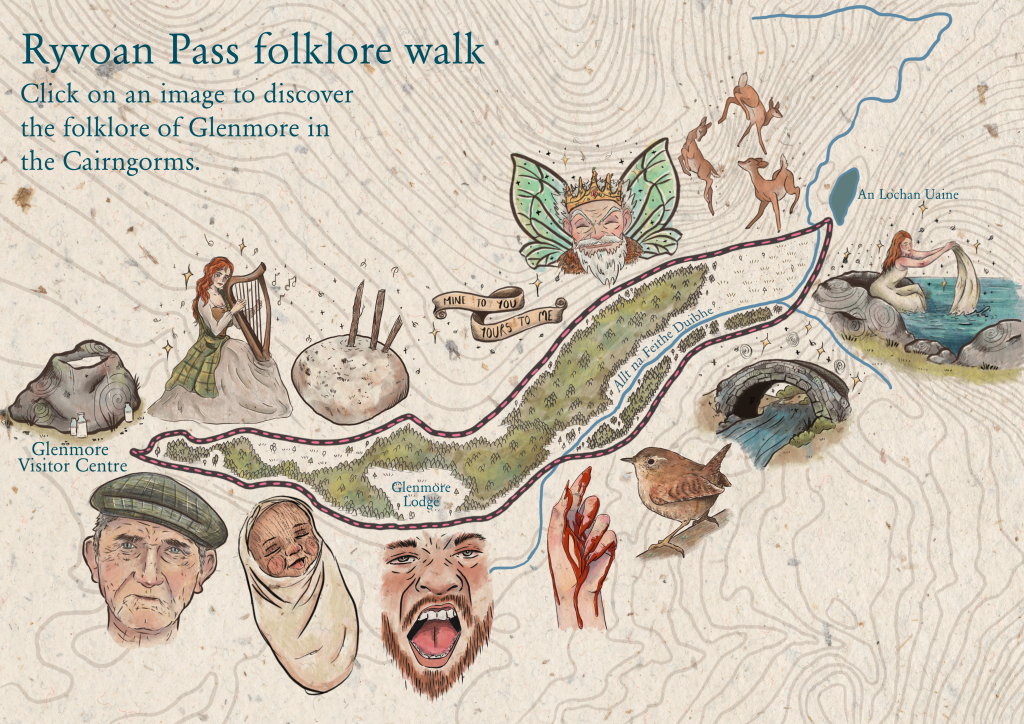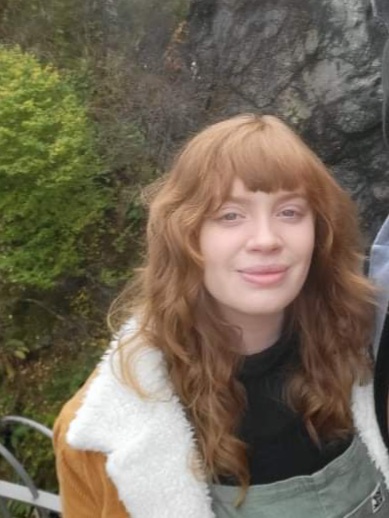Rachael Horsburgh’s Folklore Map of Glenmore Forest.
Slow living hidden in the Scottish Highlands. Connecting back to the land, re-joining nature’s rhythm through the sun and birdsong. Discovering inner peace to nurture the creative flow. This is what I found at the art residency at Inshriach Bothy thanks to the Cairngorms Youth LAG on behalf of the Cairngorms Trust.
[infogram id=”1pplvjplgxp91gfr6j32z0pzmzizkmgyev7?live”]
I had recently completed my MA in Contemporary art and archaeology with UHI Orkney with work focusing on the Cairngorms National Park. My work explored the connection between land, folklore, and society. I had been speaking to a friend about wanting to take my work further, particularly focusing on smaller areas within the Park. That evening an alumni from my undergrad University shared the post for the art residency. I knew immediately I wanted this residency and the experience it offered. I spent the next week updating my portfolio and completely forgetting that I needed to have some kind of residency plan. Two days before the deadline I had a lightbulb moment.
Harking back to my MA project and my exploration into land, folklore, and people, I came up with something similar but on a much smaller scale (land wise). With only 20 minutes before the midnight deadline, I sent my application away and crossed my fingers.
A few days passed and then I got a phone call to discuss my idea further with an online meeting. On a Friday evening in the passenger seat of a car, I found out I had been awarded the residency.
[infogram id=”1prm6rxlxnwg7lagjk3w2zmy05cmvevg5mq?live”]
On the first day of the residency, I drove through the wild countryside to my home for the next week. I was met by the lovely Bridget who accompanied me to the bothy. It was a wonderful sight. Bridget started the fire for me while I organised my things. One large rucksack, one large box of art supplies, a smaller rucksack for day trips, and a bag of food. We checked that the bothy had everything I needed before Bridget left, and then I was alone.
I started my residency by familiarising myself with the bothy. One wood burner for making food, hot water, and keeping warm. A kitchenette with a sink. One dining table with chair and bench. One desk. Two bucket chairs. And a spacious loft bed above the kitchenette. I created a small comfy nook by the dining table, laid out all my art supplies on the desk, and started my first pot of soup on the wood burner, all under candlelight as the bothy doesn’t get much sunshine after 6pm in March.
My daily routine was simple. I woke around 8am when the sun started to pour in through the bedroom window. I would clamber down the ladder and walk the 30ish metres to my composting toilet. The frosty mornings always made this more exciting. Then I would light the fire and crawl back into the warmth of my bed for half an hour. Then I’d fill the kettle, and prepare my pot of porridge, enjoying breakfast while I planned my day. In the evening I would make my tea (either soup or soupy stew), read a book under candlelight, watch a film, and then head for bed around 9pm. The nights were exciting. I was lucky to get the full moon on my second night so stayed up to watch it crest the hill above the bothy. The stars were amazing too, so clear due to the lack of light pollution. It was quiet too. I live by a railway line so to hear silence was a new experience. I had one bizarre night on Saturday. I was invited to meet the Cairngorms Youth Action Team in the afternoon and didn’t get home till late. It was dark. I had my torch and headlamp and I think my senses were on hyper alert because I felt like I could hear everything. I reached the bothy and was glad to find it still warm from the fire that afternoon. I went to put my cooler of food outside and as I did I heard strange bells in the trees just in front of me.
[infogram id=”1pr939wwenxwemug2g11g2vnx5cmqxx0jre?live”]
I’ve read many stories about hearing bells, usually accompanied by people disappearing to fairyland for many years, so I quickly placed the cooler down and ran inside. That night I woke at some point to hear the dishes below my bed getting moved about – almost like someone was doing the dishes. I knew there was something below me that clearly thought I was asleep. I lay there and listened for a bit, trying to work out what I was hearing but ultimately fell back to sleep again. In the morning nothing had moved, and I was kind of disappointed that my dishes hadn’t been done.
The first day I explored the area, trying to find a location that would best fit my art plan. I walked the landscape for most of the day, did some local research and gathered some books, then headed home to the bothy. That evening I settled on creating work around Glenmore Forest. I already knew a few folktales of the area but my research had pulled up more. The next day after my morning routine, I sat down at the desk and sketched my plan.
I wanted to make a folklore walk. One that could be easily accessible and shared as much local history, heritage, culture and folklore as I could find. Glenmore is rich with all this and more. There are many already established walks in the Cairngorms which are meticulously cared for and for that reason I thought it best to work with one of these – I didn’t want to lead anyone off into the wild in case they too ended up in a folk story. Using the information I found incorporated with my chosen path – the Ryvoan Pass trail – I combined everything together.
[infogram id=”1pj5w75kmr05yqt6d2vllm9pnwimm7y6l2z?live”]
My plan along with the walk was to create artworks that would blend into the landscape. The work, made from natural materials, was designed so that it could be left in the landscape to slowly decompose. The idea of the artwork was to play on the phrase “if you know where to look”. The pieces blend into the landscape and would only be discovered either by accident or if you already knew how or where to find them. This artwork would also mirror how fragile local folklore and stories can be. Tales passed on by word of mouth eventually disappear when they are no longer told, and not many have a written record. I wanted to capture this fragility, this loss, in a body of work whilst still recording it in another format (the walk).
My final piece of artwork became a folklore map of Glenmore Forest. Illustrations around the map hint at the different stories in the area, and selecting them would bring up images of the natural art pieces explaining these stories. I am also currently working on a short film of the walk so it can be more accessible. This way people can discover the folklore and history of the landscape even if they cannot get into the landscape themselves. I am very grateful for the art residency for allowing me to connect deeper to my work. To create pieces of work that have inspired my creative process and allowed me to connect back to the land, back to nature, and back to myself.

- Rachael Horsburgh’s Folklore Map of Glenmore Forest.
This project was made possible by a grant from the Cairngorms Youth Fund, a fund run by young people for young people. The fund was delivered by the Cairngorms Youth LAG on behalf of the Cairngorms Trust. To get involved in future youth-led activity with the National Park, get in touch with the Cairngorms Youth Action Team.
